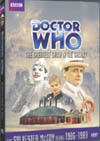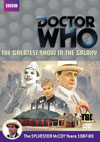DVD Extras include:
Time is taken to introduce characters properly in this story, and to celebrate who they are with enjoyable scenes. To that end, we get the best TARDIS interior scenes of the entire Sylvester McCoy era here. These are important, as they establish our main characters' reasons for going through the adventure, while also establishing Ace's major character arc for the story. Although she will get many good moments that work with that arc on the planet, no doubt her journey wouldn't work half as well without these important set-up scenes. And thumbs up for another good TARDIS materialization - the McCoy era usually satisfies in that respect. Most of the guest characters are well drawn, and get economical yet substantial scenes to demonstrate themselves to the audience, scenes that integrate quite a number of good action beats providing good structure to the story. Even with many of the characters being parodies of certain archetypes, they never quite drift so far from normality that the audience can't understand where they're coming from, and one does become emotionally engaged with most of them. The circus idea also encourages recognition and acceptance of at least two layers with each character - the performance they display professionally vs. their real emotionally vulnerable self that waits to be unmasked. The mystery twists for each character provide a lot of the intrigue for later story developments.... Characters are also quite well motivated in this tale, with the circus and its festival for new amateur recruits providing a simple and effective primary external layer for understanding why these characters are there doing what they're doing. Any actions that may raise questions are deliberately meant to. A lot of the believability problems commonly associated with candy-horror stories are helped by setting the story on an alien planet with an ancient alien culture in the background - all of which injects a healthy amount of unknown into the set-up of the situation that we have here. Additionally, we get to see the best of Sylvester McCoy's Doctor as an explorer of the unknown in this story, instead of the usual long-term manipulator who already knows what's going on. Nice. Believability also gets a bit of a boost by the fact that the Doctor does eventually recognize the final villains in the end, prompting the viewer to think back over the programme's previous 25 years to try to recognize them as well. Though we've never actually seen or heard mention of them before, the masks they wear bear a striking resemblance to that worn by Sutekh in "Pyramids of Mars" (story no. 82). Are they members of the same or a similar species/culture? It does nothing but good to imagine they are, as the villains here can inherit some of Sutekh's mental powers, and with the final conflict taking place in some alternate dimension, all the classic elements that can make candy-horror work believably are now in play. Good show. Our villains seem to be playing with less than the full human deck of emotion, desire, and thought - which works in this case to emphasize how inhuman they are. In some respects they resemble Native Americans encountering Europeans for the first time and getting their first tastes of alcohol - easily becoming addicted to it and not knowing how to control themselves very well after having some. Similarly, these aliens on Segonax seem to have little imagination themselves. Now exposed to entertainment via the circus, they can't get enough and will do any unscrupulous thing for more. Although addiction isn't really mentioned explicitly in the Doctor's analysis of these villains, it's an easy element to identify, and helps the story to work. "It was your show all along."Of course, the circus is working on another completely different level as well, becoming a parody of television programming in general, and the peculiarities of Doctor Who and its fans, general audiences, and television bosses in particular. With this device, John Nathan-Turner and the rest of the team get a chance to say things they might never otherwise say, and the story is littered with many nice little observations on the subject. It might all have been subtle enough to remain ambiguous about what is actually being referred to here, if only Ace's line at the end hadn't quite made the parallel so obvious by not really having any story-only context that it could believably refer to. Well, we don't really mind so much. This is a fun parody that really works as icing on the cake of a good story.
There are lots of good performances in this story, but Ian Reddington stands out as the Chief Clown. In many ways he offers a lot of the same qualities you'd want from the Master - and Anthony Ainley's Master in particular: the elegance, the calculated sinisterness, even the odd sympathetic beat, while exaggerating the style slightly and getting away with it due to the character being a performer already in a very unique and bizarre situation. The story also caters to Sylvester McCoy's abilities as an actor, particularly for the concluding moves, allowing him to make a few more inimitable marks on the long-running character. It would be hard to imagine most of the other Doctors pulling off what McCoy does here, although no doubt William Hartnell's facial expressions would be priceless should he have had a chance to try. But Davison, Eccleston, or Matt Smith? ...fuhgedaboutit. The story is also really good for Ace, as she matures from the newbie she was in "Dragonfire" (story no. 151) and "Remembrance of the Daleks", and develops the more fluid relationship she shares with the Doctor in "Silver Nemesis" (story no. 154) and "The Happiness Patrol" (story no. 153), while also proving that she isn't about to succumb to Janet Fielding's theory that every companion breaks the mould in their first story, and then falls right back into it for the rest of their run. Ace is going to continue to be interesting and inimitable herself in nearly every story she gets to participate in. Good one.
International Titles:Deutsch: "Die Todesmanege auf Segonax"Magyar: "A legnagyobb show a galaxisban"Français: (Le plus grand show de la galaxie)Русский: "Величайшее шоу в галактике"The German translation holds the meanings of "The Death Row on Segonax", and/or "The Death Arena on Segonax", both of which are fair descriptions of the situation.As for the others, is bigger always better? The English word "greater" can imply both at the same time, and the Russian translation seems poised to do the same. But perhaps the French "grand" and the Hungarian "nagyobb" mostly imply bigger without necessarily triggering thoughts of being better.... and I don't think the circus on Segonax is going to win many contests for its size!
Season 25 Rankings:
This story is available on DVD and VHS video. Click on the Amazon symbol for the location nearest you for pricing and availability:
Comments on this article are welcome. You may contact the author from this page:
|










